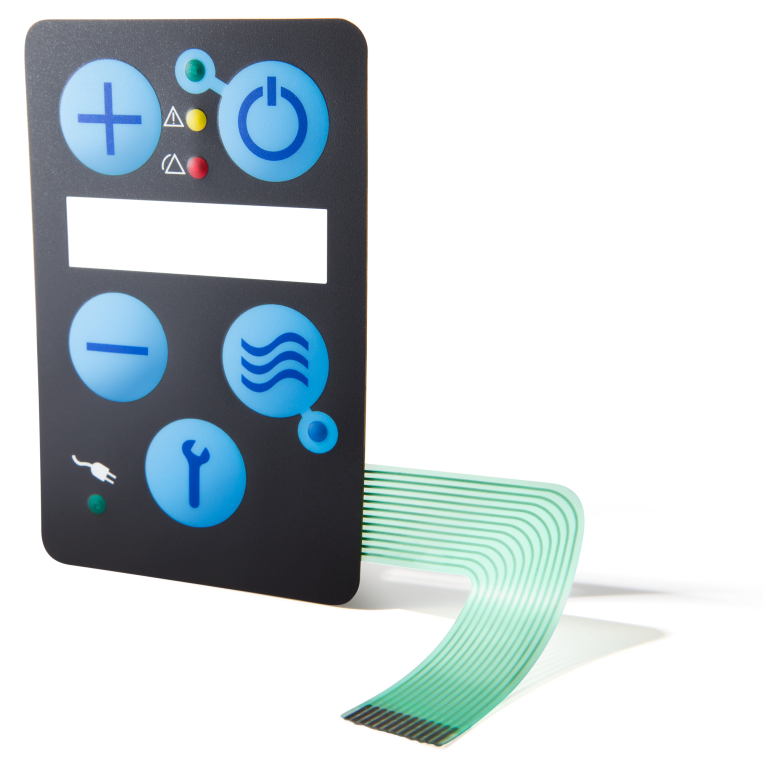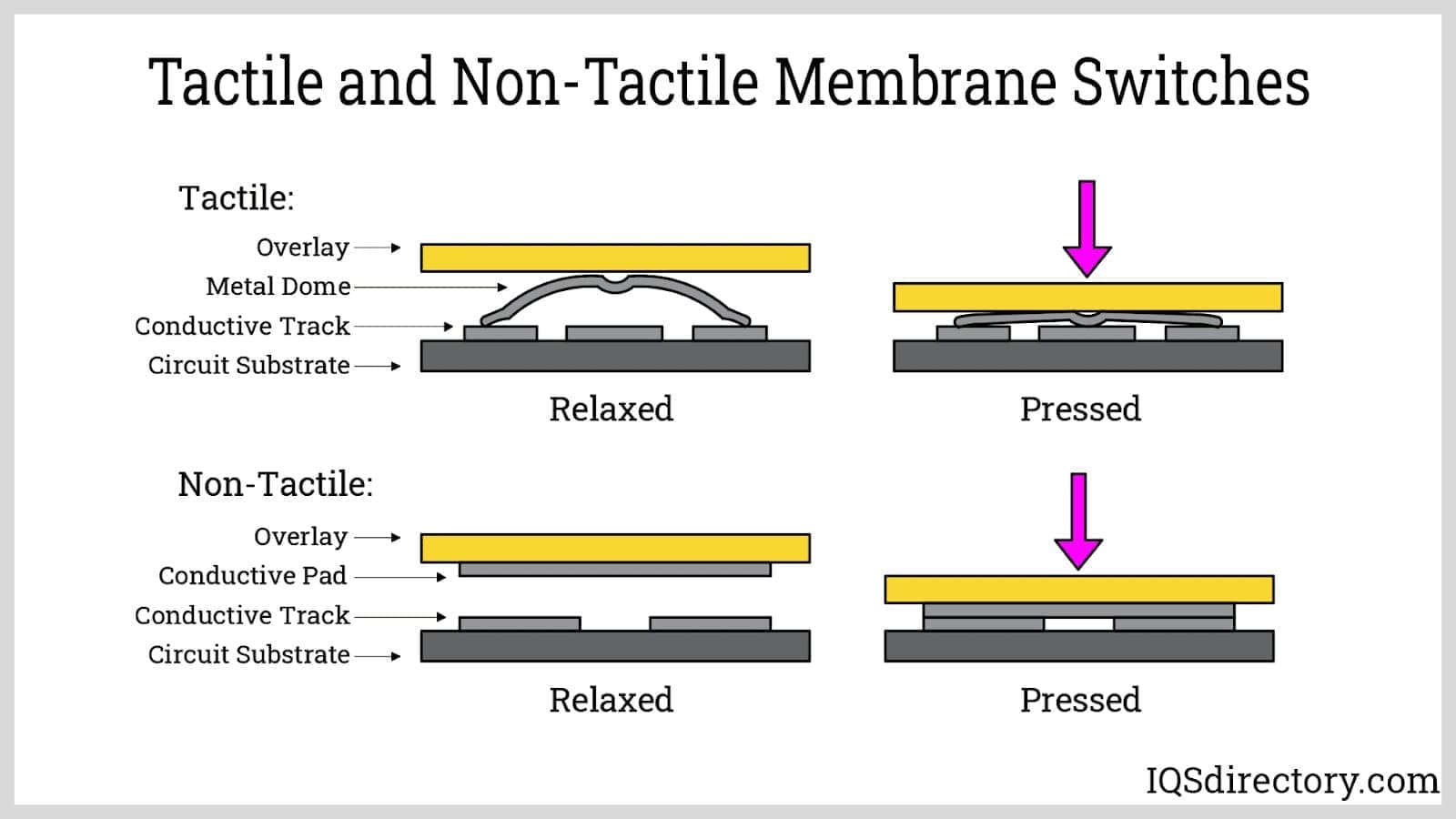Top-Performing Products from a Membrane Switch Manufacturer You Can Rely On
Top-Performing Products from a Membrane Switch Manufacturer You Can Rely On
Blog Article
Recognizing the Importance of Membrane Switch in Modern Electronics and Their Applications
Membrane changes act as an important element in contemporary electronic devices, supplying an efficient interface for user interaction. Their adjustable and light-weight nature makes them appropriate for an array of applications throughout diverse markets. Recognizing their essential components and benefits can provide insights right into their expanding importance. As modern technology remains to breakthrough, the advancement of Membrane switches increases inquiries concerning their future applications and layout innovations. What exists ahead in this dynamic area?

What Are Membrane Switches?
Membrane switches are crucial elements in modern electronic devices, acting as interface that facilitate communication in between customers and tools. These buttons contain a number of layers, consisting of a visuals overlay, a glue layer, and a circuit layer, every one of which interact to develop a functional and durable user interface. The design permits a flat, low-profile service that can be personalized concerning size, shape, and aesthetic appearance, making them appropriate for numerous applications, from consumer electronic devices to clinical gadgets. The responsive feedback provided by Membrane switches over enhances customer experience, while their resistance to dirt and moisture makes them perfect for testing environments. Membrane switches can include features such as backlighting and printed graphics, even more expanding their functionality. Their adaptability and robustness make them a recommended selection in industries where reliability and ease of usage are extremely important, ultimately adding to the smooth operation of contemporary digital gadgets.
Secret Elements of Membrane Switches Over
While numerous components add to the capability of a membrane button, three key layers play substantial duties in its design and procedure. The top layer, normally made from a durable polymer, functions as the interface for customer interaction, usually including published graphics and symbols. Under this is the spacer layer, which maintains the necessary distance between the leading layer and the circuit layer. This spacer layer warranties that the button activates just when pushed, preventing unintended inputs. The circuit layer consists of conductive traces that complete the electrical circuit when the top layer is depressed. These traces can be made from different materials, including copper or silver. Together, these parts create a dependable and robust device that is compact and flexible, ideal for a wide variety of electronic applications, from home home appliances to medical tools. Comprehending these crucial elements is important for valuing the overall capability of Membrane buttons.
Advantages of Using Membrane Switches Over

Membrane Switch Manufacturing Process
Recognizing the Membrane switch manufacturing procedure discloses the detailed actions included in generating these important elements. The process commonly starts with the design phase, where specifications and layouts are created utilizing specialized software program. Following this, the visuals overlay is printed on a versatile substrate, often using high-resolution printing techniques to guarantee clarity and precision.Next, the sticky layers are applied, which offer to bond the various elements with each other. The circuit layers, made from conductive inks or products, are then printed onto a separate substrate. These layers are carefully lined up and laminated to create a practical switch.After setting up, the buttons undergo checking to validate functionality and toughness. Quality control procedures are executed throughout the process to identify and fix any type of defects. Lastly, the completed Membrane buttons are packaged and gotten ready for distribution, all set to meet the demands of modern electronic applications.
Applications of Membrane Switches Over in Different Industries
Membrane switches are progressively used throughout various markets, particularly in medical equipment and consumer electronic devices. In the clinical area, they offer reputable control user interfaces for tools that need exact operation. Similarly, in customer electronics, these switches enhance user interaction by providing responsive and streamlined user interfaces.
Medical Equipment Control
Countless contemporary medical tools use Membrane buttons for streamlined procedure and boosted individual interaction. These buttons provide a dependable, durable interface for a variety of applications, consisting of analysis devices, patient monitoring systems, and medical tools. Their adjustable designs enable certain formats that can accommodate the special requirements of healthcare experts, making certain intuitive navigation and efficient access to vital features. Furthermore, Membrane switches are resistant to contaminants, making them suitable for sterile environments. The tactile responses they supply can boost customer self-confidence, minimizing the danger of errors during vital medical treatments. On the whole, the combination of Membrane switches in clinical devices considerably contributes to improved functional performance and individual safety and Going Here security in medical care settings.
Consumer Electronic Devices Interfaces
In the domain name of consumer electronic devices, Membrane switches play an essential duty in improving interface across a large range of devices. These buttons are essential to products such as remotes, microwaves, and video gaming consoles, providing a straightforward and effective interface. Their layout enables a smooth integration of graphics and capability, allowing manufacturers to produce sleek, contemporary aesthetic appeals without endangering usability. Membrane switches are likewise recognized for their durability, frequently enduring considerable use and direct exposure to various environmental problems. In addition, they can integrate attributes like backlighting and responsive comments, more improving the individual experience. As customer needs for sophisticated yet user-friendly user interfaces expand, Membrane changes remain to be an essential element in progressing digital device functionality.
Style Factors To Consider for Membrane Switches Over
Designing effective Membrane changes needs mindful focus to various elements that influence both performance and individual experience. One essential factor to consider is the choice of materials, as they can impact resilience, tactile comments, and aesthetic charm. Choosing an appropriate adhesive is necessary for assuring lasting attachment and resistance to ecological factors.In enhancement, the design and style of the switch should fit user interaction, with button dimensions and spacing maximized for convenience of usage. The consolidation of graphics and labeling must prioritize clarity and visibility under various lights conditions.Consideration of electric attributes, such as actuation force and switch level of sensitivity, will certainly improve the responsiveness of the Membrane button. In addition, the layout must accommodate manufacturing procedures their website to ensure cost-effectiveness and timely manufacturing. On the whole, a well-balanced design enhances both the customer and the performance experience of Membrane buttons in modern electronic devices.

Future Patterns in Membrane Switch Modern Technology
As innovation remains to develop, Membrane buttons are poised to incorporate new innovations that will boost their performance and application in numerous fields. One substantial trend is the consolidation of durable and adaptable materials, which will certainly increase the life expectancy and integrity of these buttons. Enhanced surface appearances and personalized graphics are also expected, permitting even more intuitive individual interfaces.Moreover, the combination of clever technology, such as touch-sensitive surfaces and haptic feedback, is expected to enhance customer communication, making Membrane switches more appealing and receptive. Furthermore, advances in printed electronics will enable much more complicated circuitry within thinner accounts, additionally increasing layout possibilities.Sustainability will certainly additionally play an essential duty in future developments, as manufacturers explore environment-friendly products and manufacturing procedures. Generally, these patterns will ensure that Membrane switches continue to be pertinent and indispensable in an interconnected and significantly electronic world.
Frequently Asked Questions
How Do Membrane Changes Compare to Traditional Mechanical Buttons?
Membrane changes offer advantages over standard mechanical buttons, including decreased dimension, lighter weight, and boosted toughness. They usually provide a secured surface, enhancing resistance to dirt and moisture, making them excellent for varied applications.
What Materials Are Generally Utilized in Membrane Switch Construction?

Can Membrane Switches Over Withstand Extreme Environmental Issues?
Membrane buttons can hold up against severe ecological problems, depending upon their style and products. Top notch building and constructions usually recommended you read include longevity versus temperature level changes, humidity, and exposure to chemicals, making them suitable for numerous requiring applications throughout sectors.
For How Long Do Membrane Switches Typically Last Prior To Failing?
Membrane switches typically show a life expectancy ranging from 1 to 10 million actuations, depending on factors such as use frequency, environmental problems, and producing quality. Normal upkeep can extend their durability and functional dependability considerably.
Are Membrane Changes Customizable for Details Applications?
Membrane buttons are undoubtedly customizable for details applications. They can be tailored in size, layout, and functionality, permitting makers to fulfill distinct customer demands and boost product appearances while preserving functional efficiency and toughness. Membrane switches are necessary components in contemporary electronic devices, offering as user interfaces that assist in communication between devices and individuals. The responsive responses provided by Membrane changes boosts customer experience, while their resistance to dust and wetness makes them suitable for testing environments. The incorporation of graphics and labeling must focus on quality and visibility under various lighting conditions.Consideration of electrical attributes, such as actuation pressure and button level of sensitivity, will certainly boost the responsiveness of the Membrane button. Enhanced surface textures and customizable graphics are also anticipated, enabling for more user-friendly individual interfaces.Moreover, the integration of smart technology, such as touch-sensitive surfaces and haptic feedback, is expected to boost customer communication, making Membrane changes a lot more responsive and appealing. Membrane switches over deal advantages over conventional mechanical switches, including decreased dimension, lighter weight, and enhanced sturdiness.
Report this page